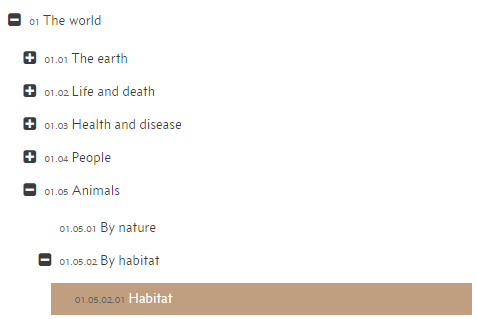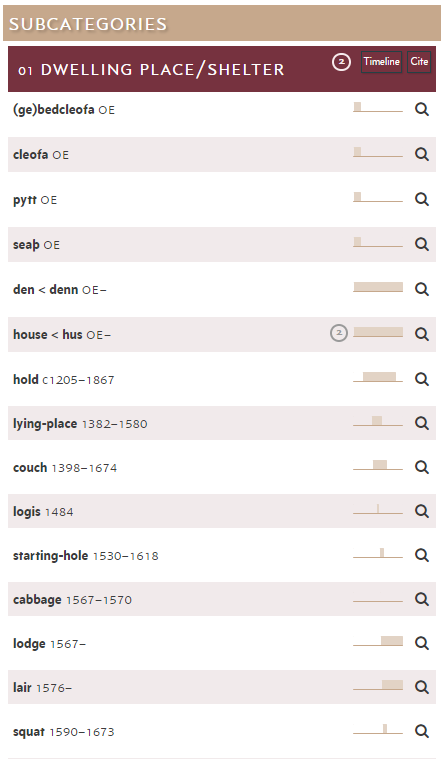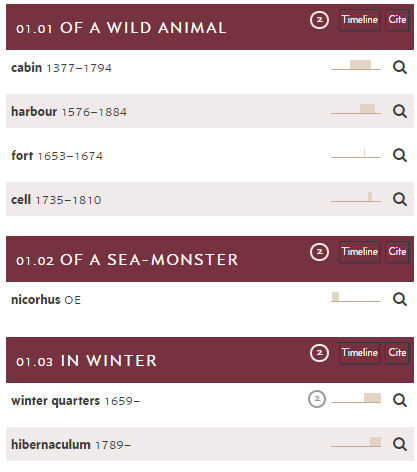Bias in Language
This experiment investigates anthropocentrism in human language using Historical Thesaurus of the Oxford English Dictionary categories.
Significance
Human languages have developed over thousands of years, across locations, ethnic groups, and cultures. They reflect cultural norms, biases and traditions. For example, Colour reflects colours of environments and places occupied by language groups.
- Nonhumans also have language, depending on the definition
Robert Macfarlane's writing highlights the decline in language about places after industrialisation.1,2 We assume nonhuman terms follow this trend. Other human languages contain many terms for landscapes, features, animals, and perceptions. Indigenous languages reflect their speakers' connection with place, but lack documentation and widespread use.
Gap
- Meaningful place representations should capture subjectivities of agents that define 'place'
- Environmental narratives such as Macfarlane's require substantial research and reflect the author's subjective experiences
- Natural language processing estimates language features such as part-of-speech, tense, and collocations.
- Extracting 'nonhuman' or 'place' terms depends on metadata about word meanings, e.g., usage, place of origin, and related concepts and terms.
- Sentiment analysis uses external sources (e.g., words labelled 'positive' or 'negative') to extract 'meaning' from unstructured text
Opportunity
- Understanding language bias helps establish understanding, empathy, solidarity, and communication
Thematic corpora (e.g., biology textbooks, literary fiction, travel narratives) could serve as benchmarks for anthropocentrism. Other groupings could include author, type of fiction, language, place of publication, narrative location, and time period. For example, one could find all 'nonhuman' terms in:
- The works of Jane Austen
- Texts written in 19th century Scotland
- Novels about 18th century England
- Histories of Ancient Rome
- All novels published after the 16th century
- Biology textbooks
- Lexicons
- The Thesaurus itself
These data could support our research goals. For example, enumerating words about animals and humans could 'measure' anthropocentrism in texts.
Questions
- Is human language anthropocentric?
- Can semantic thesauri illustrate this bias?
Methods
- Conceptual overview
- Examples of semantic networks, e.g. thesauri, lexicons, etc.
- Advantages, limitations, potential
Results
The Historical Thesaurus organises words from the 1010s to the 2000s into 240,000 categories. These categories add semantic meaning to terms that can inform text analysis. Dictionary definitions lack the structure automated analysis requires. They distinguish between human and nonhuman phenomena: perceptions, habitats, features, or groupings.

Historical Thesaurus: Screenshot of the animal habitat category (01.05.02).

01.05.02.01|01 (n.) Habitat :: dwelling place/shelter

01.05.02.01|01.01 (n.) Habitat :: dwelling place/shelter :: of a wild animal
Discussion
Potential
Limitations
Such 'nonhuman words' carry the biases of the Thesaurus' authors. Michael Samuels, a Professor of English Language at the University of Glasglow, prepared the Historical Thesaurus's first edition. Teams of researchers have continued Samuels' work. Most contributors come from linguistics, a field interested in human language. The Thesaurus draws from literary and historical sources with similar biases.
This experiment requires machine-readable data. As the Historical Thesaurus is privately owned, obtaining access requires a research aim. Describing this research project is a goal of the Place and Colour project.
Still, the presence of these terms signify human interest in nonhuman lives and environments.
Contribution
-
Relevance for designers, researchers, etc.
-
Preliminary research suggests fungi communicate using methods comparable to language.3
- Semantic data from HT could reveal patterns.
- 'Fungal language' "exceeds European languages in morphological complexity."4
-
“Though interesting, the interpretation as language seems somewhat overenthusiastic, and would require far more research and testing of critical hypotheses before we see ‘Fungus’ on Google Translate.”
-
-
Human language privileges human perceptions.
- Lacks terms to express nonhuman subjectivities and perceptions
Related projects
- evoke visualises semantic thesauri.
Footnotes
Robert Macfarlane and Jackie Morris, The Lost Words: A Spell Book (London, UK: Hamish Hamilton, 2017).˄
Robert Macfarlane, The Wild Places (New York, NY, US: Penguin Books, 2008).˄
Andrew Adamatzky, “Language of Fungi Derived from Their Electrical Spiking Activity,” Royal Society Open Science 9, no. 4 (2022): 211926, https://doi.org/10.1098/rsos.211926.˄
Mohammad Mahdi Dehshibi and Andrew Adamatzky, “Electrical Activity of Fungi: Spikes Detection and Complexity Analysis,” Biosystems 203 (2021): 104373, https://doi.org/10.1016/j.biosystems.2021.104373.˄
Backlinks